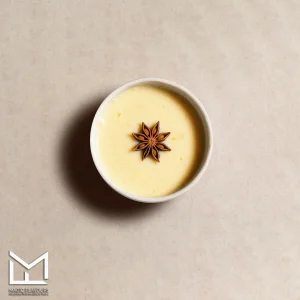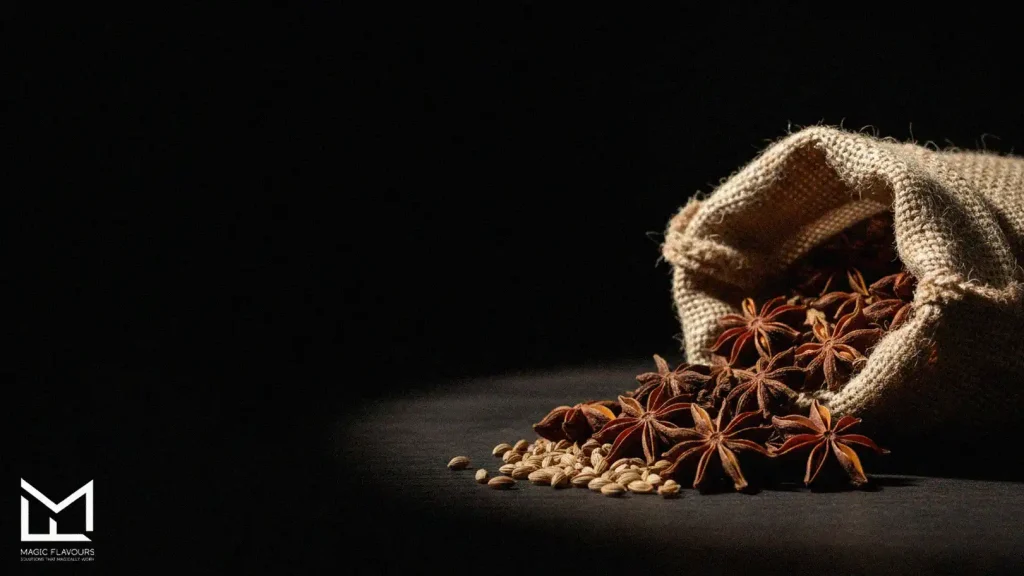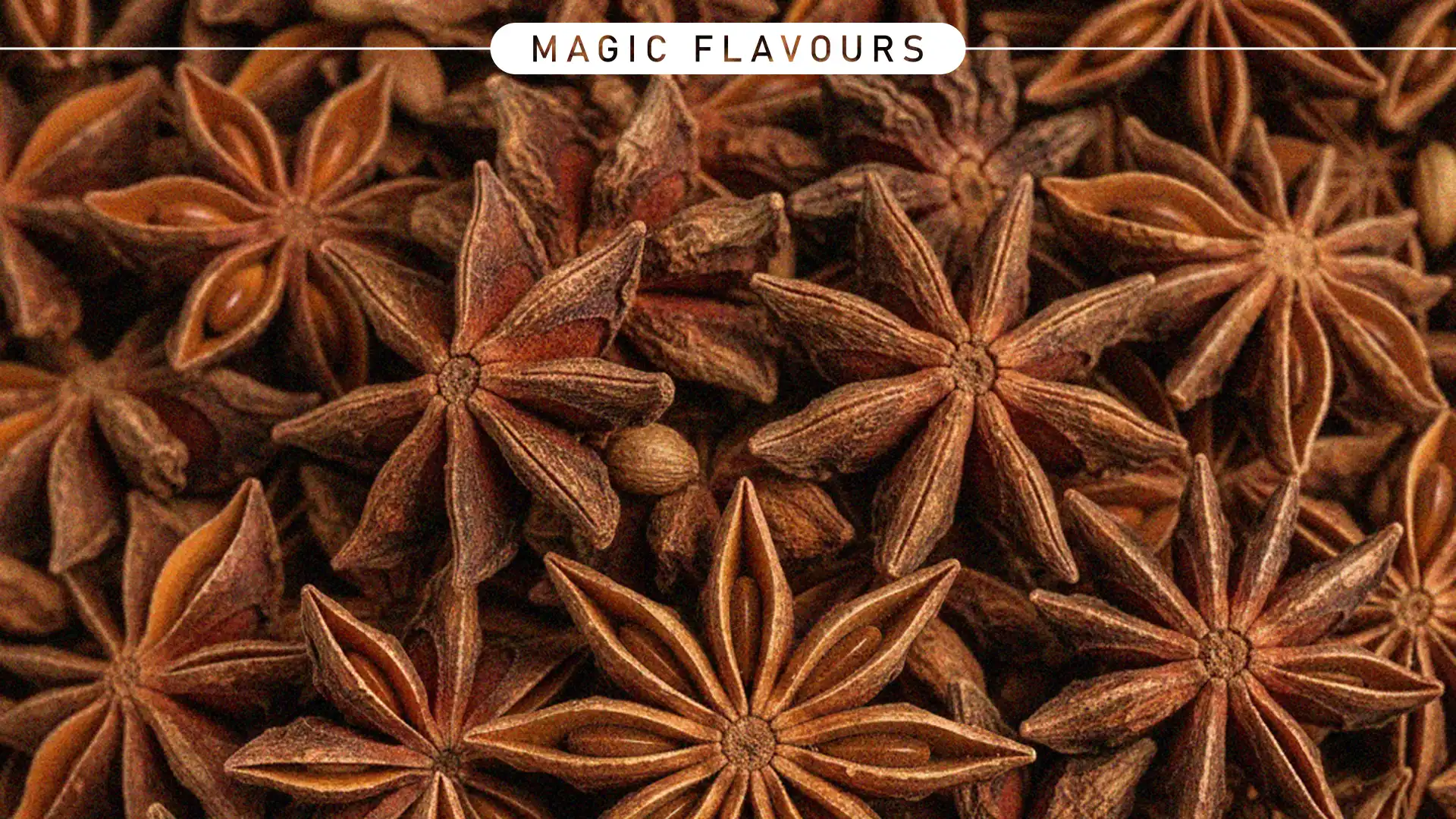1. Introduction to Anise Flavor
What Is Anise Flavor?
Anise flavor comes from the seeds of the anise plant, Pimpinella anisum. It tastes sweet, herbal, and slightly spicy. The dominant compound, anethole, gives it a strong licorice-like profile. This makes it instantly recognizable.
People often confuse this flavor with star anise or fennel. However, each plant has a distinct origin and taste. Anise flavor is softer and sweeter than star anise. It blends well with both sweet and savory ingredients.
Anise seeds are small and oval. They are usually dried and ground before use. Because of their potency, even a small amount delivers bold flavor.
Historical and Cultural Significance
This flavor has deep historical roots. For example, ancient Egyptians used it for digestion and breath freshening, while Greeks and Romans added it to wine, bread, and medicine, valuing both its taste and healing properties. In medieval Europe, anise flavored cakes and herbal tonics, and traders eventually spread it across Asia and the Middle East. As a result, its use expanded into rituals, remedies, and festive dishes, with each culture adapting it to local preferences.
Today, this flavor appears in traditional recipes worldwide. It also features in religious and seasonal celebrations. Its cultural legacy adds richness to its culinary role.
Why Anise Flavor Stands Out
This flavor stands out because of its bold, sweet, and aromatic profile. It’s unlike most other spices. Its taste is polarizing—some love it, others avoid it. That contrast makes it memorable.
Anethole gives anise flavor its signature intensity. It also contributes to its strong aroma. This compound interacts well with sugar, citrus, and alcohol. That’s why anise suits many recipes.
Chefs use anise flavor to add depth and complexity, while bakers rely on it for warmth and sweetness. Moreover, its versatility and strength make it a favorite in kitchens around the world.
2. Botanical and Chemical Profile of Anise Flavor
The Anise Plant and Its Flavor Origins

The anise plant (Pimpinella anisum) belongs to the parsley family and thrives in warm, sunny climates. Its seeds are the primary source of anise flavor, and farmers harvest them once the plant flowers and dries. Historically, anise originated in the Mediterranean region, where ancient civilizations cultivated it for both flavor and medicinal purposes. Today, it is grown across Europe, the Middle East, and parts of Asia, and its distinctive flavor remains popular worldwide.
The seeds contain essential oils. These oils carry the sweet, licorice-like taste. Drying and grinding the seeds intensifies the flavor. Therefore, processing plays a key role in flavor strength.
Key Compounds (e.g., Anethole)
Anethole is the main compound behind this flavor. It makes up most of the seed’s essential oil. This compound gives the sweet, spicy, and slightly cooling taste.
Anethole also contributes to aroma. It smells like licorice and fennel. Its chemical structure allows it to bind with fats and sugars. This helps it blend well in recipes.
Other compounds include estragole and limonene. These add herbal and citrus notes. Together, they create a complex flavor profile. That’s why anise flavor feels layered and rich.
Anise Flavor vs. Fennel, Star Anise, and Licorice
This flavor often gets compared to fennel, star anise, and licorice. All share a sweet, aromatic taste. However, each comes from a different plant and region.
Fennel has a milder flavor. It tastes more herbal and less sweet. Star anise is stronger and spicier. It comes from a star-shaped fruit in Asia.
Licorice root offers a deeper, earthy sweetness. It contains glycyrrhizin, not anethole. This flavor is cleaner and brighter. It works well in both sweet and savory dishes.
Anise Flavor vs. Fennel, Star Anise, and Licorice
Anise flavor often gets compared to fennel, star anise, and licorice. All share a sweet, aromatic taste. However, each comes from a different plant and region.
Fennel has a milder flavor. It tastes more herbal and less sweet. Star anise is stronger and spicier. It comes from a star-shaped fruit in Asia.
Licorice root offers a deeper, earthy sweetness. It contains glycyrrhizin, not anethole. This flavor is cleaner and brighter. It works well in both sweet and savory dishes.
Understanding these differences helps chefs choose the right ingredient. Each one suits a different culinary purpose.
3. Sensory Characteristics of Anise Flavor
Taste and Aroma of Anise Flavor
Anise flavor tastes sweet, warm, and slightly spicy. It resembles licorice but feels brighter and cleaner. The sweetness comes from anethole, which also adds a cooling sensation.
Its aroma is strong and herbal. It fills the air quickly, even in small amounts. The scent blends well with citrus, honey, and floral notes. That’s why it suits both desserts and drinks.
Together, taste and aroma create a full sensory experience. They trigger flavor memories and emotional responses. This makes anise flavor powerful and memorable.
Intensity and Volatility
This flavor is highly intense. A small amount can dominate a dish. Its strength depends on freshness and concentration of essential oils.
Volatility affects how quickly the aroma spreads. Anise oil evaporates fast when heated. This makes it ideal for baked goods and infused beverages.
However, overuse can overwhelm other flavors. Chefs must balance it carefully. Proper blending ensures harmony and depth in the final product.
Crossmodal Sensory Effects of Anise Flavor
Anise flavor interacts with other senses. Its aroma enhances sweetness perception. Its cooling effect adds a tactile sensation on the tongue.
Visual cues also matter. Dishes with anise often use warm colors like gold or brown. These colors suggest richness and spice, reinforcing the flavor.
Sound and texture play roles too. A crisp cookie with anise feels bold. A soft cake feels comforting. Therefore, this flavor works best when all senses align.
4. Culinary Applications
Anise Flavor in Baking and Desserts

Anise flavor adds warmth and sweetness to baked goods. It appears in cookies, cakes, and breads. Its licorice-like taste pairs well with honey, citrus, and nuts.
Bakers use ground anise seeds or anise extract. Both deliver strong flavor in small amounts. Classic recipes include Italian pizzelle and German Springerle. These treats highlight anise’s aromatic profile.
This flavor also works in custards and syrups. It adds depth without overpowering. Therefore, it’s a favorite in festive and traditional desserts.
Anise Flavor in Savory Dishes
Anise flavor enhances savory recipes with subtle sweetness. It appears in spice blends and marinades. Middle Eastern and Mediterranean cuisines use it in meat and rice dishes.
Chefs often toast the seeds to release their aroma, which deepens the flavor and adds complexity. Additionally, anise pairs well with garlic, cumin, and coriander, balancing bold spices with a soft finish. In stews and braises, this flavor mellows over time, infusing the dish without dominating. For this reason, it is especially suited to slow-cooked recipes and layered flavors.
Anise Flavor in Beverages (Alcoholic and Non-Alcoholic)
Anise flavor is popular in drinks. It stars in liqueurs like ouzo, sambuca, and absinthe. These beverages highlight its sweet and cooling qualities.
In non-alcoholic drinks, anise appears in herbal teas and syrups. It soothes digestion and refreshes the palate. Some cultures serve anise tea after meals. Others use it in festive punches.
Bartenders use this flavor to add depth to cocktails. It pairs well with citrus, mint, and spice. Its bold profile makes it ideal for signature drinks and seasonal blends.
Regional Dishes Featuring Anise Flavor
Anise flavor appears in dishes across the globe. In Iran, it flavors rice and pastries. In India, it’s part of spice blends like garam masala and chai.
European cuisines use anise in breads, sausages, and cookies. For instance, French pain d’épices and Spanish tortas de aceite showcase how each dish reflects local taste and tradition. Meanwhile, Asian recipes use this flavor in broths and sauces, adding warmth to soups and stir-fries. Altogether, its global reach highlights both its versatility and its cultural importance.
5. Cultural and Global Traditions
Anise Flavor in Middle Eastern and Mediterranean Cuisine
This flavor is deeply rooted in Middle Eastern and Mediterranean cooking. It often appears in breads, pastries, and spice blends, where chefs use it to add warmth and sweetness to savory dishes like lamb stew or rice pilaf. Moreover, in Mediterranean baking, this flavor enhances cookies and festive breads. For example, Greek koulourakia and Turkish çörek are classic examples. The seeds are often toasted to release their aroma and deepen the overall flavor.
Anise also appears in herbal teas and digestive tonics. These drinks soothe the stomach and refresh the palate. Its versatility makes it a staple in both every day and celebratory meals.
Anise Flavor in European Cooking and Confectionery
European cuisines use this flavor in both sweet and savory recipes. It stars in German Springerle and Italian pizzelle. These cookies rely on anise for their signature taste and aroma.
In France, this flavor appears in pain d’épices and pastis. In Spain, it enhances tortas and liqueurs. Each region adapts the flavor to local traditions and ingredients.
Anise also flavors sausages and breads. It balances rich meats and adds depth to dough. Its presence in European kitchens reflects centuries of culinary heritage.
Anise Flavor in Asian Culinary Practices
Asian cuisines use this flavor in broths, sauces, and spice blends. It adds warmth and complexity to savory dishes. In fact, Chinese five-spice powder includes star anise, which shares a similar taste. Likewise, in India, this flavor appears in masalas and chai, where it complements cardamom, cinnamon, and clove. Its sweet notes also balance heat and bitterness in layered recipes. Furthermore, Southeast Asian dishes feature this flavor in soups and marinades, enhancing depth without overpowering. Altogether, its role in Asian cooking highlights its remarkable adaptability across cultures.
Ritual and Medicinal Uses
This flavor has long been used in rituals and remedies. In fact, ancient cultures believed it aided digestion and calmed the mind. Moreover, it often appeared in ceremonial drinks and healing tonics. In traditional medicine, this flavor is also used to treat coughs, bloating, and insomnia. Herbalists continue to value its soothing properties, while its essential oils are widely used in teas, syrups, and inhalants.
Religious and seasonal rituals include anise-flavored foods. These dishes carry symbolic meaning and emotional comfort. Therefore, this flavor connects taste with tradition and wellness.
6. Health and Nutritional Aspects of Anise Flavor
Digestive and Medicinal Benefits
This flavor is known for its digestive benefits, as it helps reduce bloating and gas after meals. In fact, many cultures use anise tea to soothe the stomach and ease discomfort.
Its essential oils have mild antibacterial properties. They may help fight infections and calm inflammation. Traditional medicine also uses this flavor to relieve coughs and improve sleep.
“These effects come from compounds like anethole and flavonoids. Because they support relaxation and gut health, this flavor often appears in herbal remedies and wellness products.
Nutritional Composition of Anise Seeds
Anise seeds are small but nutrient-rich. They contain fiber, protein, and healthy fats. They also offer calcium, iron, and magnesium in modest amounts.
The seeds are low in calories but high in flavor. A small serving adds taste without heaviness. Their essential oils provide antioxidants that support overall health.
Anise seeds also contain B vitamins. These help with energy and metabolism. Therefore, they offer both flavor and nutritional value in cooking.
Safety, Allergies, and Usage Guidelines
This flavor is generally safe in food amounts. Most people tolerate it well. However, large doses of anise oil may cause nausea or dizziness.
Some individuals may have allergies to anise or related plants. Symptoms include skin irritation or breathing issues. It’s important to test small amounts before regular use.
Pregnant or nursing individuals should consult a doctor before using anise medicinally. As with any strong spice, moderation is key. Proper use ensures safety and enjoyment.
7. Flavor Pairing and Innovation with Anise Flavor
Best Flavor Pairings with Anise Flavor (e.g., Citrus, Honey, Cinnamon)
Anise flavor pairs well with citrus. Lemon and orange add brightness and balance. Honey softens its intensity and adds floral sweetness.
Cinnamon complements anise with warmth and spice. Together, they create rich, layered profiles. Vanilla and almond also work well, especially in baked goods.
Savory pairings include garlic, cumin, and coriander. These spices balance anise’s sweetness. Choosing the right pairing enhances complexity and harmony in recipes.
Modern Fusion Recipes Using Anise Flavor

Chefs use this flavor in fusion dishes to surprise and delight. Moreover, it appears in spiced chocolate, citrus-glazed meats, and herbal cocktails, where tradition meets innovation. In addition, this flavor adds depth to vegan desserts and gluten-free breads. It also pairs beautifully with coconut, maple, and ginger, while its bold profile makes it ideal for signature creations. Furthermore, fusion recipes often combine global influences — anise meets chili, soy, or mint in unexpected ways. Ultimately, this creativity keeps the flavor fresh and exciting.
Challenges in Balancing Anise Flavor
Anise flavor is strong and polarizing. Too much can overpower a dish. Its sweetness may clash with bitter or sour ingredients.
Chefs must measure carefully. A pinch can enhance, but a spoonful may overwhelm. Blending with neutral flavors helps soften its impact.
Texture also matters. Crisp foods release this flavor quickly. Soft ones hold it longer. Balancing intensity and delivery ensure a pleasant experience.
8. Market Trends and Consumer Preferences for Anise Flavor
Popular Products Featuring Anise Flavor
Anise flavor appears in a wide range of products. It stars in liqueurs like ouzo, sambuca, and absinthe. These drinks highlight its sweet, herbal profile and strong aroma.
Confectionery brands use this flavor in candies, gums, and cookies. Furthermore, it adds both depth and nostalgia. In particular, baked goods like pizzelle and pain d’épices rely on anise for their signature taste.
Health products also feature this flavor. Herbal teas, syrups, and lozenges use it for soothing effects. Its versatility makes it popular across food, drink, and wellness categories.
Consumer Attitudes Toward Anise Flavor
Consumer opinions on anise flavor are mixed. Some love its bold, licorice-like taste. Others find it overpowering. This split makes it a niche but loyal market.
Fans associate anise flavor with tradition and comfort. It reminds them of holidays, rituals, or childhood treats. This emotional connection drives repeat purchases and brand loyalty.
Younger consumers explore anise flavor through fusion recipes and cocktails. They enjoy its complexity and uniqueness. Therefore, targeted marketing helps brands reach both nostalgic and adventurous audiences.
Flavor Forecasting and Innovation in Anise Flavor
Flavor forecasting shows renewed interest in bold, herbal profiles. In line with this trend, anise flavor is gaining traction. Chefs and product developers use it in modern blends and global fusions.
Innovators pair this flavor with citrus, floral, and smoky notes. These combinations refresh its image. New formats include anise-infused oils, spreads, and plant-based desserts.
Sustainability also influences flavor innovation. Brands seek natural sources and clean-label ingredients. This flavor, with its strong identity and health appeal, supports this movement.
9. Conclusion
Summary of Anise Flavor’s Culinary Impact
Anise flavor has shaped global cuisine for centuries. It adds warmth, sweetness, and complexity to countless dishes. Naturally, from cookies to cocktails, its bold profile leaves a lasting impression.
Its versatility makes it valuable. In fact, this flavor works in sweet, savory, and even medicinal recipes. Moreover, cultures worldwide embrace it in traditional meals and festive treats.
Despite its polarizing nature, this flavor remains essential. Chefs and bakers rely on it for depth and character. Its culinary impact is both historic and ongoing.
Future Directions in Anise Flavor Innovation

Flavor innovation is expanding, and anise flavor now appears in plant-based, gluten-free, and fusion recipes. Moreover, chefs are experimenting with new pairings and formats to continually refresh its appeal.
Technology supports this growth. AI and data help predict trends and guide product development. Sustainability also matters. Brands seek clean-label, natural sources of anise flavor.
As global tastes evolve, this flavor adapts accordingly. Moreover, its bold identity makes it ideal for creative exploration. Finally, future recipes will blend tradition with modern flair.
Final Thoughts on Embracing Anise Flavor
By embracing this flavor, you welcome boldness. Moreover, it challenges the palate while rewarding curiosity. In addition, its sweet, herbal notes offer both comfort and surprise.
Whether in a classic cookie or a modern cocktail, this flavor adds depth. It connects cultures, memories, and emotions through taste. Therefore, crafting with this flavor takes care and balance. But when done well, it transforms a dish. That’s the power of flavor—bold, timeless, and unforgettable.
